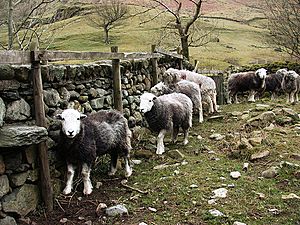Extensive farming facts for kids

Extensive farming is a way of growing crops or raising animals that uses a lot of land but not much help from people, special tools, or money. It's different from intensive farming, which uses less land but more resources to get a lot of food.
Contents
How Extensive Farming Works
Extensive farming often involves raising animals like sheep and cattle. This usually happens in places where the land isn't great for growing lots of crops. But it also includes growing large amounts of grains like wheat and barley.
For example, in the Murray-Darling Basin in Australia, the soil is very old and not very rich. This means farmers don't get a huge amount of crops from each small piece of land. However, because the land is flat and the farms are huge, a few people can manage very large areas.
A special type of extensive farming is nomadic herding. This is where herders move their animals from place to place. They follow the seasons to find fresh grass and water for their animals.
Where Extensive Farming is Found
You can find extensive farming in many parts of the world. It's common in the middle sections of most continents. It's also used in desert areas where there isn't enough water to grow many crops.
Because extensive farming uses large areas of land, it doesn't need as much rain as intensive farming. The farms are usually very big compared to the number of people working on them or the money spent. For instance, in 1957, some parts of Western Australia had such poor grasslands that only one sheep could live on a whole square mile of land!
Benefits of Extensive Farming
Extensive farming has several good points compared to other farming methods:
- Less work per area: You don't need as many people to farm very large areas. This is especially true because farmers don't have to change the land much, like building terraces.
- Better for machines: Large, flat areas are perfect for using big farming machines.
- Cheaper food: Because farmers can work more efficiently, the food produced often costs less.
- Good for animals: Animals usually have more space to move around. This means they are often healthier and happier than animals kept in smaller spaces.
- Fewer chemicals needed: This type of farming doesn't need as many things like fertilizers.
- Protects the environment: If animals eat plants that naturally grow in the area, there are fewer problems with plants that don't belong there. Also, the local environment and soil are not harmed by too many chemicals.
- More efficient animals: Animals raised in larger areas tend to grow better.
Challenges of Extensive Farming
Even with its benefits, extensive farming can have some challenges:
- Lower yields: In the short term, you usually get less food from the same amount of land compared to intensive farming.
- Habitat loss: Because it needs so much land, extensive farming can reduce the natural homes for wild animals and plants. This can be a problem, just like with intensive farming.
Some people used to think that extensive farming created more harmful gases like methane and nitrous oxide per kilogram of milk than intensive farming. However, newer studies suggest that extensive animal farming might actually be better for the environment than intensive systems.
See also
 In Spanish: Agricultura extensiva para niños
In Spanish: Agricultura extensiva para niños
- Herding
- Pastoralism
- Ranching
- Slash-and-burn agriculture
- Transhumance
Images for kids
-
Continuous grazing by sheep or cattle is a widespread extensive farming system, with low inputs and outputs.


